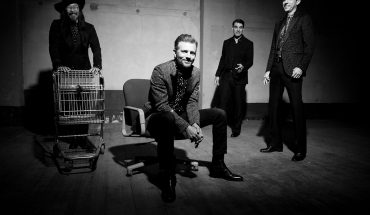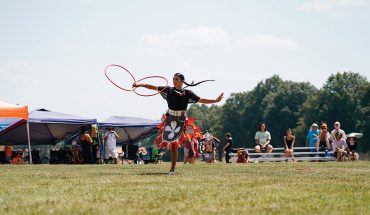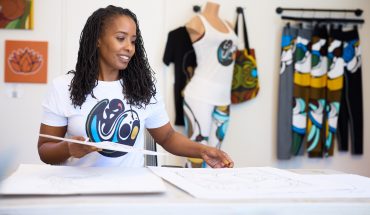
by Burke Koonce
photographs by Missy McLamb
In September 1976, on the Aldert Root Elementary School playground, there were really only three legitimate male “role models” for first grade boys. Hawkeye Whitney, the star forward on the N.C. State basketball team, was one. Clyde Austin, also of the State basketball team, was another, and then there was Phil Ford, the great Carolina point guard. By Thanksgiving of that year, a boy might have chosen President-elect Jimmy Carter as a role model, and a year later, he might have gone with Han Solo. But in September of 1976, a star basketball player represented everything that a six-year old Raleigh boy, or at least this six-year-old boy, could aspire to become – masculine and cool.
In 1976, dads who had first-graders weren’t role models, at least not the way we use the term today, which is now more analogous to “non-smoker.” In those days, a dad likely wasn’t a non-smoker, literally or figuratively. A dad was a man who lived in the house where your mother was trying to raise you. A dad came and went pretty much as he pleased, and a boy was generally well-served to stay out of his way. That’s why we wanted to be Hawkeye Whitney or Phil Ford. We could read about them in The News and Observer or, in the evening, The Raleigh Times. They played a game that we understood and could actually play, sort of.
A dad? Dads were basically a mystery. They just didn’t have a whole heckuva lot to say. Sure, your dad might take you out to Reynolds Coliseum or over to Carmichael for a ball game. And many dads were endowed with incredible stamina, driving station wagons all the way up or down Highway 70 to Tweetsie Railroad or to the Sea Hawk Motor Lodge for a weekend. But what did they do when they went to work? What did they do all day when they weren’t with you? I knew my dad went to something called the Kiwanis Club from time to time, and he went to work in an office on Atlantic Avenue that smelled like ammonia and overlooked an open field that is now a bridge over Capital Boulevard. But that was about it.
So, masculine? Absolutely. Cool? How could a six-year-old know?
At the same time, a new program at the Raleigh YMCA called Indian Guides was attempting to change some of that. The program, which is now known nationally as Y Guides, was growing in popularity in Raleigh, but it was not yet by any means considered a rite of passage.
But somehow, Raleigh commercial mortgage broker John Dickinson, whose son Michael was at Root, became aware of it and recruited eight other dads to join him in what had to have been considered at the time a radical social experiment – the dads would commit to spending one Sunday night every month between September and April dressed up like Indians – the term “Native Americans” was not yet in common use – to teach manly things to their young sons. For those of us in the first grade, this was the equivalent to an invitation to fly to the moon with actual astronauts – something that had in fact only been accomplished seven years prior.
Nine dads, 10 boys, no moms or sisters. And we each got our own Indian name! John and Michael Dickinson were Walking Bear and Running Bear. Ed Lilly and Steven Lilly were Flying Eagle and Fighting Eagle. Larry and Bo Maddison were Red Falcon and Black Falcon (CPA humor). John and Johnny McConnell were Big Horn and Little Horn. Ed and John Moore were Red Owl and Horned Owl. Buzzy and Vann Russell were Big Foot and Little Foot. John C. and Owen Williams were Big Wave and Little Ripple. Jerry Young, the jeweler, was Shining Rock, and Graham and George Young were Little Rock and Little Pebble. Everybody had amazing Indian names. Everybody, that is, except me. Typically, my dad, Marvin Koonce, older than most of the other dads, had gone out and researched North Carolina Indian lore – and came up with Junaluska for himself and Oconaluftee for me. Lilly got to be Fighting Eagle. I was an unpronounceable river near Cherokee. Not cool.
For the next three years, we were the Ocracoke tribe. And, well, we basically did get to fly to the moon. Before there was a Sunday night meeting at your house, you had to deliver handmade invitations, often inscribed on a cross-section of a small tree, to each member of the tribe. That meant you were spending not one but two evenings per month with your dad, one at the meeting, and one riding around in the front seat with no seat belt delivering the invitations you had just crafted.
At the meetings, we told ghost stories, built bird feeders out of pine blocks, assembled battery-powered light bulbs, and observed the strict rule of the talking stick. Whomever had the talking stick could speak, but no one else. The credible threat of actual corporal punishment meted out immediately made it actually work.
The annual pilgrimage to Camp Sea Gull was a major highlight; so was the unsanctioned side trip to the Texasgulf phosphate plant near Aurora, where we searched for shark’s teeth among mountains of sediment freshly dredged from the floor of the Atlantic. If you couldn’t find a megaladon tooth in there – well, there was just no helping some people. Dinner at The Trawl Door in Oriental. Jeep-powered trailer rides not just around but into the camp lake. The long trip back to Raleigh, exhausted, with empty Wendy’s Frosty cups on the floor of the Buick from one half of the group and several empty airplane bottles from the other.
And then, after the three-year program run was over, the Ocracoke tribe, like the other YMCA Indian Guide tribes, disbanded. But then something unusual began to happen. Or rather, began to not happen.
Nobody ever said goodbye.
We started to matriculate at different schools, yes, and then different colleges and different careers, but we never lost touch with each other. With unusual frequency, we would find ourselves at a meal or social gathering and realize that everyone present was in our tribe. We had unintentionally begun to hold mini-Ocracoke reunions.
In 1996, the Ocracoke tribe held its first official meeting in two decades – a 20th reunion dinner at the Angus Barn, and all but two members were still living in Raleigh. By the next one, the 25th reunion at the Barn, the only member who wasn’t living here flew back for the occasion (and got lost between the airport and the Barn in a labyrinthine new development called Brier Creek). By the 30th, everyone was back living in Raleigh, though we had lost the first dad – my own. By the 35th, we had lost another, Jerry Young, and by the 40th, we had lost another, John C. Williams.
As a father myself now, with two children who are already post Y Guides, I cannot fully explain the Ocracoke tribe and what it is that keeps us together. I know that what binds us is not mere nostalgia, even though we do reminisce. The population of Raleigh was about 172,000 when the Ocracoke tribe first met. Soon it will be half a million. It’s not inertia helping keep us together. It’s gravity. There’s a lot going on in Raleigh.
But I think what really keeps us in each other’s orbit is the gentle but genuine interest we have in each other’s lives that we learned from first watching our fathers together forty years ago. It was fascinating. Spending time with your own dad was wonderful on its own; but observing those nine fathers who were not already lifelong friends like we would turn out to be, but who thought to share their time with us taught us a certain humility and mutual respect. They were different from one another, and they weren’t perfect, but perfection wasn’t the goal – it was commitment to nurturing us. It was, in its essence, love.
When we gathered at the Angus Barn in October, someone observed that there wasn’t so much as a single divorce among either generation. These Indian Guides had done their job well. They were gentlemen and family men, and they still are. And they weren’t role models. They were heroes.
And, Dad, thank you for naming me Oconaluftee. Turns out it’s pretty cool being different. I love you too.



